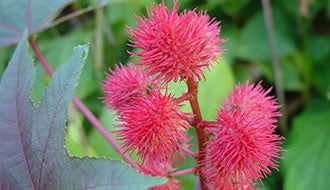Plants can be grouped together because of their botanical relationship to each other, appearance or historical relationship to humans or each other. Collections based on botanical relationships might include only plants from one family, like camellias or maples. Collections based on appearance might include only plants with white flowers or fragrant flowers. An example of a collection based on history is a primitive plant garden
Camellia Garden
The Camellia Garden, located in front of Jenkins Hall on the Armstrong campus, displays a great number of camellia species and other members of the Theaceae family.
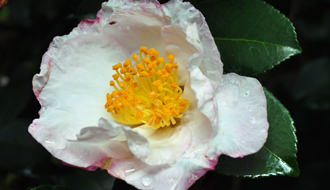
The Camellia Garden, located in front of Jenkins Hall on the Armstrong campus, was established to test the landscape potential of camellia species grown along the Georgia coast. We optimistically assumed that since Camellia japonica and Camellia sasanqua grow so well here, at least some of the 280 other species of camellia would thrive as well. Our 28,000-square-foot garden contains over 50 species of camellia, along with an interesting complement of camellia relatives, including the genera Eurya, Franklinia, Gordonia, Polyspora, Schima, and Ternstroemia.
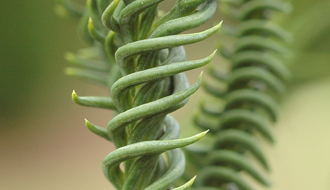
Conifer Garden
The Conifer Garden, located on the east side of Burnett Hall on the Armstrong campus, contains over 140 different conifers representing 24 genera.
The Conifer Garden, located on the east side of Burnett Hall on the Armstrong campus, contains over 140 different conifers representing 24 genera. Conifers are the most numerous and widespread of the gymnosperms living today, with 50 genera and about 550 species, and they grow from the subarctic to the subtropics.
Conifers hold many superlatives in the plant kingdom, representing the world’s tallest, largest, thickest, and oldest living trees. The tallest is the Coast Redwood (Sequoia sempervirens), reaching a height of 378 feet. The largest is the Giant Sequoia (Sequoiadendron giganteum), with a volume of 52,509 cubic feet. The thickest tree, with the greatest trunk diameter, is the Montezuma Cypress (Taxodium mucronatum), measuring 37 feet in diameter. The oldest is the Great Basin Bristlecone Pine (Pinus longaeva), nicknamed Methuselah, and believed to be about 4,700 years old.
Conifers are also highly resilient, thriving in stressful environments where other plants may not survive. They can withstand drought, high winds, extreme heat, and numbing subzero cold.
Fern Garden
The Fern Garden, located in front of Jenkins Hall on the Armstrong campus, displays both native and non-native ferns and their allies.
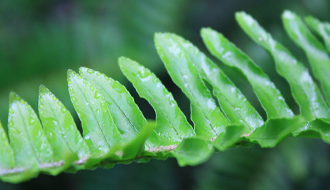
The Fern Garden, located in front of Jenkins Hall on the Armstrong campus, displays both native and non-native ferns along with their allies. Ferns flourished in the warm, moist, swampy environments of the late Paleozoic Era (360–245 million years ago) and thrived on Earth for nearly 200 million years before flowering plants appeared.
Although most early fern species became extinct, some survived and evolved into the 10,000 species of modern ferns found across the globe today. Ferns represent a major step in the evolutionary development of plants. Like mosses, they reproduce by spores, but ferns advanced further by developing a vascular system—specialized cells that transport fluids throughout the plant.
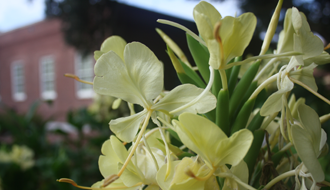
Ginger Garden
The Ginger Garden, located on the Armstrong campus at the south end of Hawes Hall, contains plants belonging exclusively to the Zingiberaceae family.
The Ginger Garden, located at the south end of Hawes Hall on the Armstrong campus, contains plants belonging exclusively to the Zingiberaceae family. This diverse family includes more than 1,300 species, many of which are economically important worldwide.
Most gingers grow best in partial to full shade, though some varieties thrive in full sun. As herbaceous perennials, gingers prefer rich, fertile soil and consistent moisture. At the Armstrong campus, they are planted in mounds of aged, finely milled pine bark mixed with sand.
Common Genera in the Ginger Garden
- Alpinia – The largest genus in the ginger family with about 150 species. Upright plants range from 1 to 12 feet tall, many with fragrant foliage. Also known as Shelled Gingers, Alpinias grow best in light shade to full sun.
- Costus – Known as Spiral Gingers due to the spiral growth of leaves around their stems. This diverse group includes mounding, spreading, and upright forms ranging from 1 to 10+ feet tall. Flowers vary from crepe-like petals to bright tubular blooms emerging from cone-shaped structures. Some thrive in shade, while others prefer sun.
- Curcuma – Often called Hidden Gingers because their flowers develop near the ground and are concealed by broad, tropical foliage. Heights range from under 1 foot to 8 feet. Most grow well in partial sun, though some tolerate brighter conditions.
- Globba – Known as Dancing Ladies, these compact gingers grow to about 2 feet tall and feature pendulous flowers in shades of white, yellow, and purple. They require shady conditions.
- Hedychium – Also called Butterfly Gingers, these are popular with gardeners for their ease of growth. Upright growers ranging from 2 to 8 feet tall, they tolerate full sun and wet soils. Their sweetly fragrant flowers bloom in red, pink, orange, yellow, or white.
- Kaempferia – Grown mainly for their multicolored, patterned foliage, these Peacock Gingers make excellent groundcover in dark, shady places. Their flowers are usually small, pale lavender, and less noticeable.
- Zingiber – Includes the common culinary ginger. These upright or arching plants have dark, glossy leaves and produce unusual, striking flowers.
International Garden
The International Garden celebrates the diversity of the university community by displaying plants from around the world. The International Garden is located between Hawes Hall and Solms Hall on the Armstrong campus.
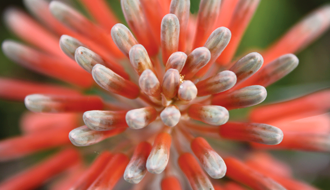
The International Garden, part of the Armstrong Campus Arboretum at Georgia Southern University, celebrates the diversity of the university community by showcasing plants from around the world.
Designed as both an educational resource for students and an outdoor gathering space, the garden features plazas representing the continents of Africa, Asia, Australia, Europe, and South America. Each plaza is surrounded by plants native to its continent, with a focus on species that hold historical, cultural, or economic significance.
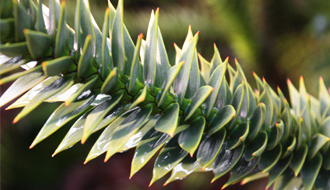
Primitive Garden
The Primitive Garden, located next to Jenkins Hall on the Armstrong campus, presents a walk through time by displaying living relatives of ancient plants.
The Primitive Garden, located next to Jenkins Hall on the Armstrong campus, presents a walk through time by displaying living relatives of ancient plants. Plants in the collection represent three important stages in the expansion of the earth’s flora. The invasion of land, along with the development of the seed and the appearance of flowering plants, represent the three most significant events in the history of plants.
The Invasion of Land
The first plants had it easy. They floated around supported by ocean, absorbed nourishment through their cell walls, and reproduced easily by releasing their reproductive cells in the water to meet and form tough capsules that could float around and find new places to live. Living on land was much tougher. Drying winds and large temperature swings prevented those early water plants cast ashore by waves or trapped in evaporating pools from living very long. To adapt to life on land, plants needed to develop substances to prevent their exterior surfaces from drying out, specialized cells for the transport of water and nutrients, and maybe most importantly, an effective method of sexual reproduction.
Early land plants found that effective method of reproduction utilizing spores produced by a unique process called alternation of generations. Alternation of generations is a cycle between adult plants and another stage that is kind of an intermediate phase. The intermediate phase is not the same thing as a juvenile stage. Juvenile plants eventually become adult plants while those in an intermediate stage will never become adult plants. The stages can be thought of as different generations within the same life cycle and are easy to see in plants that reproduce by spores. The adult generation, what we usually see when we look at plants, produces the spores. The spores germinate and develop into the intermediate generation. The intermediate generation produces sex cells- sperm and eggs. Union of these sex cells produces an adult plant and the cycle continues. The greatest limitation of this system, at least as it applies to early land plants like ferns and horsetails, is the necessity of a film of surface water for the sperm to swim in to unite with the eggs. No free water means no reproduction and explains why ferns don’t usually grow and reproduce in arid environments. Within the plant kingdom, dominance of generations varies. The earliest land plants, like mosses and lichens, have the intermediate generation dominant, so when you see moss growing on the ground you are looking at the intermediate generation of its life. Ferns and horsetail produce small but completely independent intermediate generations. Through time, plants show a progression of increasing adult generation dominance and intermediate generation reduction from the ferns up to the flowering plants.
The Development of the Seed
Most early land plants produced one size of spore. Upon germination, these spores grew into the intermediate generation which produced both male and female sex cell producing organs. In many of these plants it is possible for sperm to fertilize the eggs from the same intermediate plant. This causes problems when the success of a species relies on genetic variability in a population.
Some early spore producing plants produced two different sized spores; a larger spore that produced female sex cells, and a smaller one that produced male sex cells. At some point in time, the adult generation no longer released the female spore to develop into an independent, intermediate generation. Instead, the female spore developed into an egg producing intermediate generation on the adult and became completely dependent on it. Male sex cells in the form of pollen were transported to the female eggs by the wind, thus freeing plants from their dependence on surface water to reproduce. Larger female spores contained a greater food reserve ensuring nourishment for the undeveloped, adult plant in the form of a seed. Seeds are dormant, protected, embryo adult plants. The role of dispersal once assumed by spores was taken over by the seed.
The development of the seed provided a major innovation in plant reproductive strategy and is certainly the primary reason for the dominance of seed plants in today’s flora. In examining the seedless plants, it becomes obvious that the adult generation can only grow where the intermediate generation can succeed. Because of its dependence on water, the intermediate is the weak link in the life cycle. The development of the seed allowed plants to reproduce sexually without the necessity of external water, and provided protection and nutrients for the developing embryo. Seeds can be dispersed long distances and can remain viable for long periods of time. (How long can seeds last? Carbon-14 dating has shown that 10,000-year-old seeds of Lotus are viable and will still germinate!) These traits allowed plants to expand their range away from streams and watery sites to higher and drier environments.
Flowering Plants
Most early seed plants relied on wind to transfer pollen from plant to plant. Large quantities of pollen must be produced to ensure that some will reach its target. Wind pollination is most effective in plant communities where the wind-pollinated plants are dominant, common, and closely spaced. Coniferous forests and grasslands represent good examples of wind pollinated plant communities. Botanist theorize that some of the early wind pollinated plants produce resins and gums on their egg producing structures to increase the chances of pollen sticking to them. These gummy substances also possibly attracted insects interested in a sticky treat. The sticky insects unknowingly transferred pollen stuck to their bodies from one plant to the next and insect pollination was born. Plants continued to develop increasingly attractive structures and substances, like flowers, nectar, and fruit to increase the likelihood of animals assisting them in pollination and dissemination. Flowering plants took over most terrestrial habitats in an astonishingly short period of time displacing many ferns and non-flowering seed plants. How did flowering plants and their animal helpers so thoroughly take over most of the earth’s plant communities? Imagine a large coniferous forest made up of pines and spruces. A flowering plant on the fringes of this forest with help from an animal seed disperser could move into the under story and grow in an opening left by a tree fall. A wind pollinated plant would have little chance of being pollinated being so isolated from others of its species but the flowering plant with its mobile animal pollen vectors could be successfully pollinated. Structural differences also allow flowering plants to grow more rapidly than the non-flowering seed plants so our isolated plant in the forest quickly out competes any of the existing plants around it for sunlight and water. Animal pollination allows plants to be smaller, more isolated, and less common than wind pollinated plants. Animal pollinators will travel considerable distances from plant to plant to seek the reward of a “sticky treat”.
Physic Garden
The Physic Garden, located in front of Ashmore Hall on the Armstrong campus, displays plants with medicinal properties.
